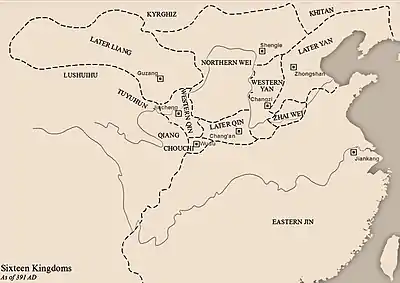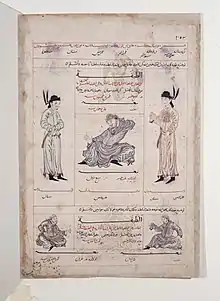Later Liang (後涼) 酒泉 (387–389), 三河 (389–396), 涼 (396–403) | |||||||||||||
|---|---|---|---|---|---|---|---|---|---|---|---|---|---|
| 386–403 | |||||||||||||
 Later Liang in the northwest | |||||||||||||
| Capital | Guzang | ||||||||||||
| Government | Monarchy | ||||||||||||
| Tian Wang | |||||||||||||
• 386–400 | Lü Guang | ||||||||||||
• 400 | Lü Shao | ||||||||||||
• 401–403 | Lü Zuan | ||||||||||||
• 403–406 | Lü Long | ||||||||||||
| History | |||||||||||||
• Established | 386 | ||||||||||||
• Lü Guang's claiming of imperial title | 396 | ||||||||||||
| 397 | |||||||||||||
• Disestablished | 403 | ||||||||||||
• Lü Long's death | 416 | ||||||||||||
| |||||||||||||
| Today part of | China Kyrgyzstan | ||||||||||||
The Later Liang (simplified Chinese: 后凉; traditional Chinese: 後凉; pinyin: Hòu Liáng; 386–403) was a dynastic state of China and one of the Sixteen Kingdoms in Chinese history.[1] It was founded by the Lü family of the Di ethnicity.
All rulers of the Later Liang proclaimed themselves "Heavenly Prince" (Tian Wang).
Rulers of the Later Liang

Later Liang rulers in a 14th-century manuscript of Rashid al-Din's world history, the Jami' al-Tawarikh
| Temple name | Posthumous name | Personal name | Duration of reign | Era names |
|---|---|---|---|---|
| Taizu | Yiwu | Lü Guang | 386–400 | Tai'an (太安) 386–389 Linjia (麟嘉) 389–396 Longfei (龍飛) 396–400 |
| – | Lü Shao | 400 | – | |
| – | Ling | Lü Zuan | 400–401 | Xianning (咸寧) 400–401 |
| – | Lü Long | 401–403 | Shending (神鼎) 401–403 | |
Rulers family tree
| Later Liang | |||||||||||||||||||||||||||||||||||||||||||||||||||||||||||||||||||||||||||||||||||||||||||||||||||||||||||||||||||||||||||||
|---|---|---|---|---|---|---|---|---|---|---|---|---|---|---|---|---|---|---|---|---|---|---|---|---|---|---|---|---|---|---|---|---|---|---|---|---|---|---|---|---|---|---|---|---|---|---|---|---|---|---|---|---|---|---|---|---|---|---|---|---|---|---|---|---|---|---|---|---|---|---|---|---|---|---|---|---|---|---|---|---|---|---|---|---|---|---|---|---|---|---|---|---|---|---|---|---|---|---|---|---|---|---|---|---|---|---|---|---|---|---|---|---|---|---|---|---|---|---|---|---|---|---|---|---|---|
| |||||||||||||||||||||||||||||||||||||||||||||||||||||||||||||||||||||||||||||||||||||||||||||||||||||||||||||||||||||||||||||
See also
References
- ↑ Grousset, Rene (1970). The Empire of the Steppes. Rutgers University Press. pp. 59–60. ISBN 0-8135-1304-9.
This article is issued from Wikipedia. The text is licensed under Creative Commons - Attribution - Sharealike. Additional terms may apply for the media files.